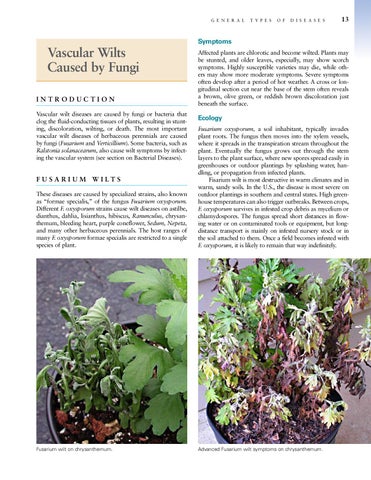general
Vascular Wilts Caused by Fungi In t r o d u c t i o n Vascular wilt diseases are caused by fungi or bacteria that clog the fluid-conducting tissues of plants, resulting in stunting, discoloration, wilting, or death. The most important vascular wilt diseases of herbaceous perennials are caused by fungi (Fusarium and Verticillium). Some bacteria, such as Ralstonia solanacearum, also cause wilt symptoms by infecting the vascular system (see section on Bacterial Diseases).
types
of
diseases
13
Symptoms Affected plants are chlorotic and become wilted. Plants may be stunted, and older leaves, especially, may show scorch symptoms. Highly susceptible varieties may die, while others may show more moderate symptoms. Severe symptoms often develop after a period of hot weather. A cross or longitudinal section cut near the base of the stem often reveals a brown, olive green, or reddish brown discoloration just beneath the surface.
Ecology
These diseases are caused by specialized strains, also known as “formae specialis,� of the fungus Fusarium oxysporum. Different F. oxysporum strains cause wilt diseases on astilbe, dianthus, dahlia, lisianthus, hibiscus, Ranunculus, chrysanthemum, bleeding heart, purple coneflower, Sedum, Nepeta, and many other herbaceous perennials. The host ranges of many F. oxysporum formae specialis are restricted to a single species of plant.
Fusarium oxysporum, a soil inhabitant, typically invades plant roots. The fungus then moves into the xylem vessels, where it spreads in the transpiration stream throughout the plant. Eventually the fungus grows out through the stem layers to the plant surface, where new spores spread easily in greenhouses or outdoor plantings by splashing water, handling, or propagation from infected plants. Fisarium wilt is most destructive in warm climates and in warm, sandy soils. In the U.S., the disease is most severe on outdoor plantings in southern and central states. High greenhouse temperatures can also trigger outbreaks. Between crops, F. oxysporum survives in infested crop debris as mycelium or chlamydospores. The fungus spread short distances in flowing water or on contaminated tools or equipment, but longdistance transport is mainly on infested nursery stock or in the soil attached to them. Once a field becomes infested with F. oxysporum, it is likely to remain that way indefinitely.
Fusarium wilt on chrysanthemum.
Advanced Fusarium wilt symptoms on chrysanthemum.
F u s a r i u m w i lt s
